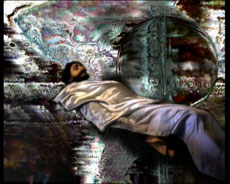Peter Callas
Statement
Peter Callas is a pioneer of the artistic use of the electronic image in Australia. Over the last two and a half decades he has utilised a wide variety of electronic and digital media to create an ongoing series of cultural ‘portraits’, making challenging work from varied locations, often during sustained periods of residence, in places such as Papua New Guinea, Japan, the United States, Germany, Brazil, Italy, and India as well as Australia.
His persistent themes have been to address the issues of multicultural and transcultural identity and the ‘reanimation’ of history.
Many of his video works are in the permanent collections of numerous museums worldwide, including the National Gallery of Australia, Canberra; the Museum of Modern Art, New York, USA; the Long Beach Museum of Art, USA; the Donnell Media Center, New York, USA; the Kawasaki Museum, Japan; the Australian Centre for the Moving Image, Melbourne; the National Gallery of Victoria, Melbourne; the Art Gallery of NSW, Sydney; Queensland Art Gallery, Brisbane; the Parliamentary Art Collection, Canberra; the University of Sydney Art Collection; the Kunsthaus Zürich, Switzerland; the Kunstmuseum, Bonn, Germany; the Zentrum für Kunst und Medientechnologie (ZKM), Karlsruhe, Germany; and the Centro de Arte Reina Sofia, Madrid, Spain.
His works have been included in a number of significant group exhibitions worldwide including Modern Means: Continuity and Change in Art, 1880 to the Present - Highlights from the Museum of Modern Art, New York, Mori Art Museum, Tokyo, 2004; the Clemenger Contemporary Art Award Exhibition, National Gallery of Victoria, Melbourne, 2003; oZone: Australian Digital Media Art, Pompidou Centre, Paris, 2003; Heterosis-Digital Art from Australia, Centro Cultural Conde Duque, ARCO, Madrid, 2002; Animania: 100 anni di esperimenti nel cinema di animazione, Pesaro, Italy, 1998; Kwangju Biennale, Korea, 1995; Multimediale IV, ZKM, Karlsruhe, Germany, 1995; Alternative Realities: Australian Artists working with Technology, Ian Potter Gallery, University of Melbourne and numerous venues throughout Asia; Identities: Art from Australia, Taipei Museum of Fine Arts, 1994; Video Positive, Tate Gallery, Liverpool, UK, 1993; Video: Two Decades, Museum of Modern Art, New York, 1992; Strangers in Paradise, National Museum of Modern Art, Seoul, Korea, 1992; Third Emerging Expression Biennial, Bronx Museum of the Arts, New York, 1991; Australian Perspecta, Art Gallery of New South Wales, Sydney, 1981, 1989, and 1991; 1st Biennial of the Moving Image, Reina Sophia, Madrid, 1990; 1st Adelaide Biennial, 1990; Traversals: Instructions to the Double, Long Beach Museum of Art, 1990; Video and the Computer, Museum of Modern Art, New York, 1989; Art of Music Video, Long Beach Museum of Art, Long Beach and US-wide tour, 1989 & 1990; European Media Art Festival, Osnabrück, Germany, 1988; Video Cocktail, Hara Museum of Contemporary Art, Tokyo, 1986; Pleasure of the Gaze, Art Gallery of Western Australia, Perth, 1985; Continuum ‘83, Video Gallery Scan, Tokyo, 1983; L'Australie: le Reve et le Reel, Museum of Modern Art, Paris, 1983; and the Biennale of Sydney, 1982.
Callas has held retrospective screenings of his video works at the Museum of Modern Art, New York; the Kunstverein, Cologne; the ICA, London; and the Berlin Film Festival. His most recent retrospective, Peter Callas: The Invisible Histories of the Present, at Millenáris Park, Budapest, Hungary, 2006, was held across two galleries and showed 20 moving images works simultaneously along with a comprehensive collection of his prints. His videos have been screened frequently on television stations worldwide, including BBC2, London; Canal +, Paris; SAT1, Cologne; WGBH, Boston; NHK Satellite, Tokyo; Television Española, Madrid; and the ARS TV NETWORK, European Satellite TV Channel, Rome.
In 2002-03 ‘Asialink’ toured Peter Callas: Anti-Terrain, a major solo exhibition of Callas' video and photomedia print works, to Galeri Petronas, Kuala Lumpur, Malaysia; the Art Museum of the China Millennium Monument, Beijing, China; the ‘Jeongu International Film Festival’, Jeongu, Korea; and the National Gallery of Modern Art, Mumbai, India, where it occupied the entire museum.
Callas' video works have won numerous awards including First Prize, ‘Bonn Videonale’; the Golden Switchblade Award, ‘New York International Video Festival’; Honourable Mention, ‘Ars Electronica’, Linz, Austria; World Graph Prix, ‘Euro Video Fest’, Lisbon; Grand Prix, ‘International Festival of Video Art’, Locarno; and Best Computer Art, ‘Videobrasil’, São Paulo. He is also a recipient of the New Horizons Award for Innovation in New Media, International Society for the Arts, Sciences and Technology, Berkeley, USA. In 2005 he was a nominated finalist in the World Technology Awards, San Francisco, USA.
Amongst many commissions he has completed work for Carnivale, Sydney; Luna Park, Sydney; the Adelaide Festival; the Museum of Contemporary Art, Sydney; the Powerhouse Museum, Sydney; the Australian Bicentennial Travelling Exhibition; and Pioneer Laserdisc, Tokyo.
Callas has been artist-in-residence at Marui Koendori Television, Marui Department Store, Tokyo, 1986; the Visual Arts/Craft Board Studio, PS1, New York, 1989; and at ZKM, Centre for Art and Media, in Karlsruhe, Germany, 1994-1996. In 1999 Peter Callas was the HC Coombs Creative Arts Fellow at the Australian National University, Canberra. In 2001-02 he and his wife, jeweler Yuri Kawanabe, undertook a four month ‘Asialink’ residency at Sanskriti Kendra in Delhi, India. In 2003-2005 Peter Callas was an Australia Council Fellow.
